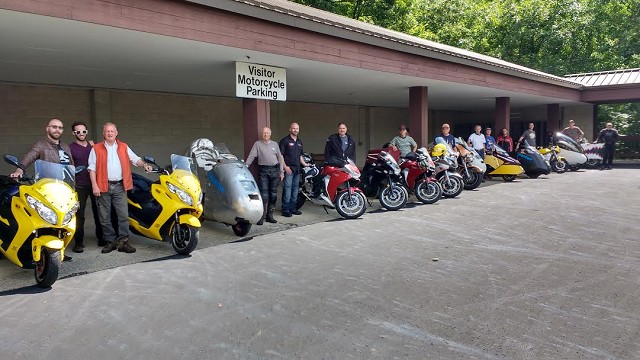
On Saturday, July 8, 2017, in the area northeast of Bellville, Ohio, a group of 12 vehicles participated in a Vetter Fuel Economy Challenge. The goal of the ride was to benchmark and document the impact of streamlining on fuel efficiency. The ride was free and open to all. Craig Vetter has published rules for doing a Vetter Fuel Economy Challenge http://craigvetter.com/pages/2012-Fuel-contests/2012-challenge-rules.html
The ride started at 8:45am from the Comfort Inn in Bellville and continued 94 miles with stops at points of interest for refreshment and fellowship.
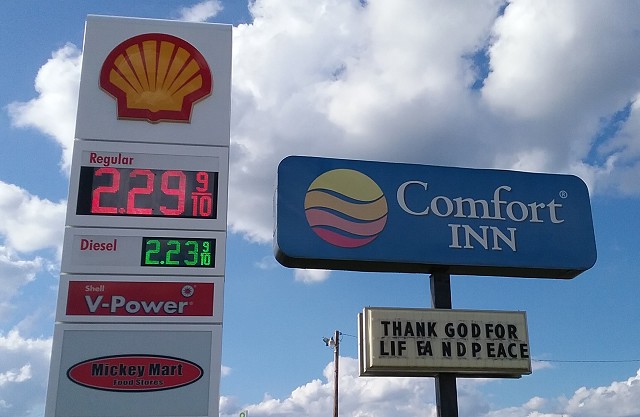
Fuel Prices at the Shell Station July 8, 2017
There was a coffee break at the Gathering Grounds Coffee House in Wooster where the bikes were checked for their ability to carry four bags of groceries.
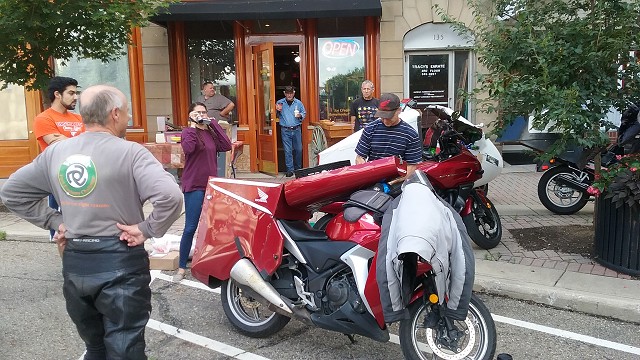
Scott Endlers Bike during Grocery bag check
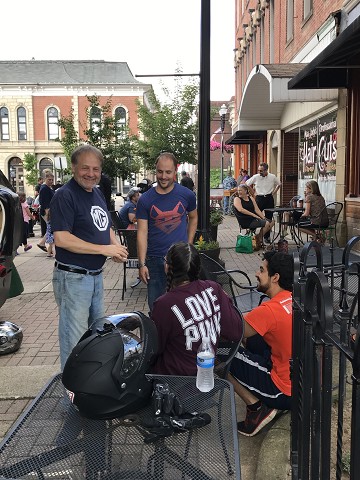
We enjoyed healthy food and drink at coffee shop.
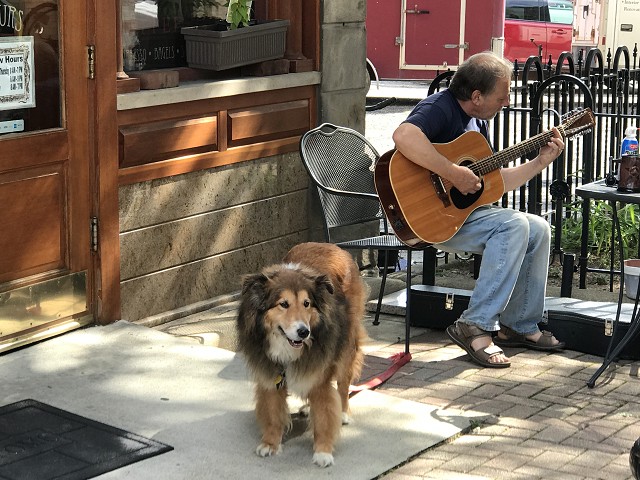
Stephen Kovach, the owner of the coffee shop, played his guitar.
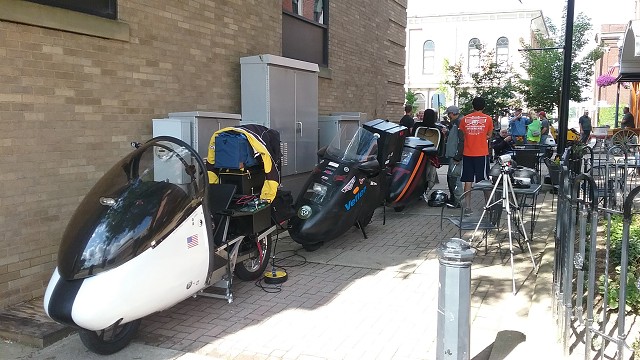
Electric motorcycles recharged from RV50 outlets in the walkway in front of the coffee shop.
Then, the group rode to Loudonville to enjoy lunch at the Hanover House Diner.
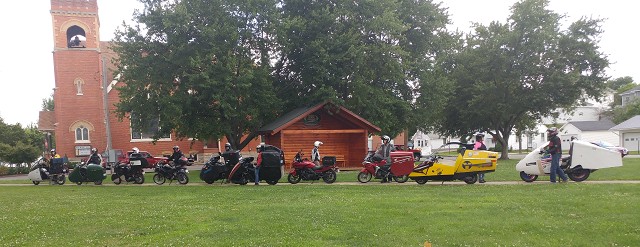
Photo Op at the park in Loudonville
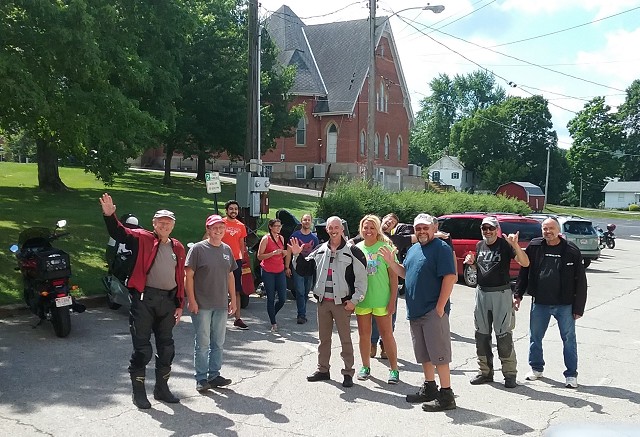
The riders and support teams on the way to lunch Left to Right: Alan Smith, Finnie Wagaman, Youssef Bourdi, Sarah Cartee, Jacob Dennis, Greg Faulkner, Galye Faulkner, Ben Schloop, Woody Wagaman, Vic Valdes, Richard Goff, Paul Wright
We stopped at the Mohican National Memorial and the Mid-Ohio Race Track before returning to the starting point to fill up and report our fuel consumption numbers.
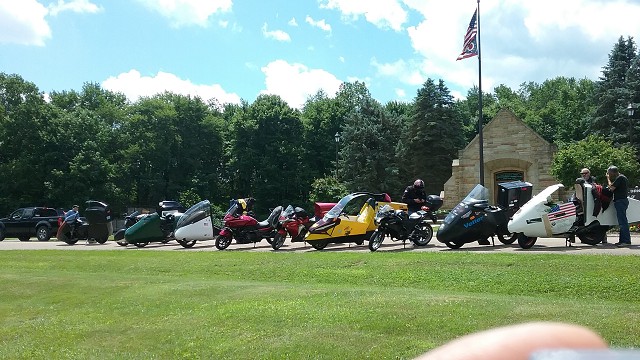
The Mohican National Memorial Forest Monument Remembers the 20,000 Ohioans Lost in War
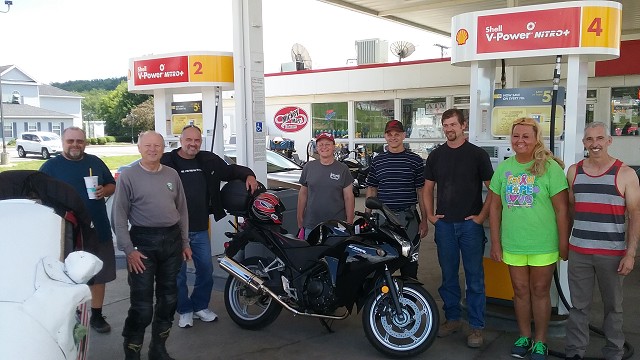
The final fill-up. Left to Right: Woody Wagaman, Alan Smith, Paul Wright, Finnie Wagaman, Scott Endler, Ben Schloop, Gail Faulkner, Greg Faulkner
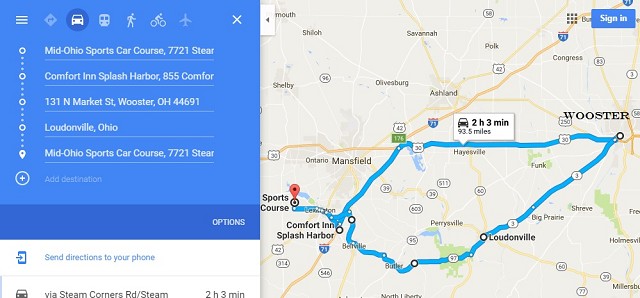
Route Taken
LEG 1: †Destination: Gathering Grounds Coffee House,†131 North Market Street, Wooster, OH (38 miles at an Average Speed of 55 MPH)
We started the ride at about 8:45am on Saturday, July 8th. We left the Splash Harbor Comfort Inn parking lot, a column of 11 motorcycles, the Virginia Tech chase truck with trailer, and Gail Faulkner in her pickup truck. Kraig Schultz D-11 Electric was lead rider, Vic Valdes was the tail rider for the motorcycles, the trucks followed behind Vic.
We immediately entered the entrance ramp for I71 and headed north at a speed of 70mph for 11 miles. We then headed west on State Road 30 at 60mph for about 23miles. We exited at Wooster and went to the Gathering Grounds Coffee House, for our grocery bag check (this year we used bags of laundry instead of groceries), 10% discounted food and drink, electric motorcycle charging and fellowship. Some electrics and gas riders said that our speed on the highway was more than enough and faster than they would normally ride.
LEG 2: †Destination:†Hanover House Diner, 153 W Main St, Loudonville, OH 44842 (20 miles at an Average Speed of 42 MPH)
After about an hour at the coffee shop, we mounted up and rode down State road 3 at 55mph to Loudonville. In Loudonville, we took a group picture at one of the city parks, then we ate lunch at the Hanover House Dinner. The electric motorcycles charged from their parking spots next to the park across the street from the public restrooms.
LEG 3 & 4: Mid-Ohio Raceway and Comfort Inn (36 miles at an Average Speed of 38 MPH)
As soon as lunch was done we jumped on the bikes and headed out for Mid-Ohio Raceway via State Route 97 at posted speed limits. We took 3 south out of Loudonville, turned onto 97. We made a quick stop at the Mohican Memorial. Near Bellville, we detoured off 97 on 13 to miss some traffic around the Comfort Inn and rode to the track. We were perfectly timed to get every traffic light in Lexington, but that helped keep the group together. At the track, the electrics from V. Tech went into the track to recharge and everyone else turned around and we rode back to the gas station at Comfort Inn to fill up and record our fuel usage.
The total ride was 94.9 Miles at an average speed of 45 mph. The temperature was approx. 65-70 degrees, calm with a slight breeze after lunch.
The vehicle fuel tanks were topped off before leaving on the ride, and each returned to the same refueling point to top off at the end of the ride.
Two electric bikes (VTech and Richard Goff) started from the racetrack and so they finished the ride when we stopped at the racetrack.
Electric bikes kept track of their recharge energy when they plugged in at the rest stops along the way.
Fuel economy statistics from the ride are summarized here:
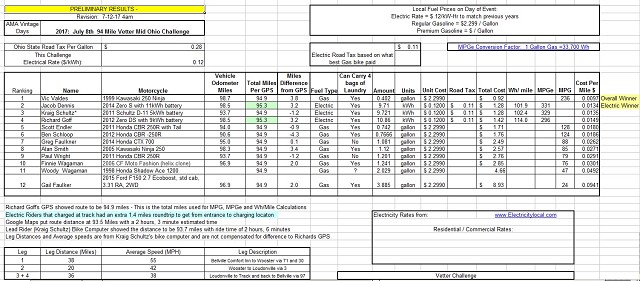
Click Here for a larger image
Multi-Year Comparison Data Matrix:
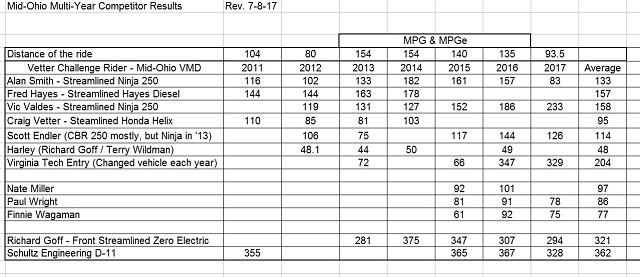
Click Here for a larger image
Multi-Year Comparison Data Graph:
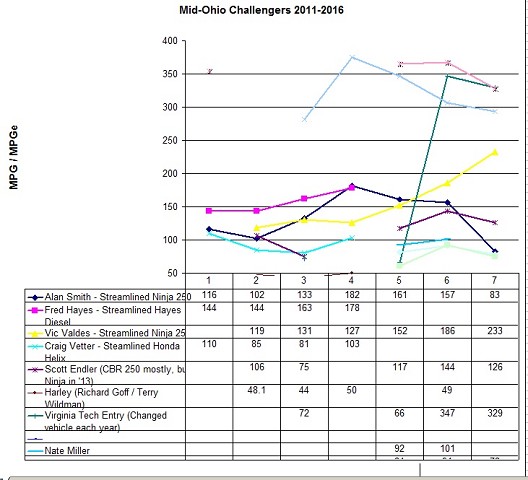
Click Here for a larger image
1. Vic Valdes (Streamlined Ninja 250 - Gasoline) - Overall Winner
2. Virginia Tech Team (Streamlined Zero - Electric) - Electric Winner
3. Kraig Schultz (Semi-Streamlined Custom - Electric)
4. Richard Goff (Streamlined Zero - Electric)
5. Scott Endler (Semi-Streamlined Honda CBR250R - Gasoline) - Rode in from New York
6. Ben Schloop (Streamlined Honda CBR250R - Gasoline) - Rode in from Michigan
7. Greg Faulkner (Stock Honda CTX700 - Gasoline)
8. Alan Smith (Semi Streamlined Ninja 250 - Gasoline) - Rode in from California
9. Paul Wright (Stock Honda CBR 250R - Gasoline)
10. Finnie Wagaman (Streamlined CF Moto Fashion) - Rode in From Pennsylvania
11. Woody Wagaman (Stock Honda Shadow Ace 1200) - Rode in From Pennsylvania
12. Gail Faulker (Stock Ford F150 Truck) - Rode in from Tennessee
All Bikes at 60mph
Leaving Loudonville
Leaving Wooster
Alan Smith Interview
Alan Grocery Check
Ben and Alan
Ben Schloop Interview
Ben Schloop Grocery Check
Ben and Alan
Greg Faulkner Interview:
Greg Grocery Check
Finnie Wagaman Interview 1
Finnie Interview 2 on Sidewinds and Side Doors
Finnie Grocery Check
Finnie on I71
Kraig Schultz Battery Swap
Kraig Grocery check
Kraig Riding
Paul Wright Interview
Paul Wright Grocery Check
Scott Endler and Paul Wright on I71
Richard Goff Interview
Richard Grocery Check
Richard on I71
Scott Endler Interview
Scott Grocery Bag Check
Scott Endler and Paul Wright on I71
Virginia Tech 1
Virginia Tech 2
Virginia Tech Grocery Check
Jake on I71
Woody Wagaman Interview
Vic and Woody on I71
Vic Valdes Interview
Vic Interview 2
Vic Grocery Check
Vic and Woody on I71
Part of Presentation with Craig Vetter and Terry Hershner on July 9th, 2017 at Vintage Motorcycle Days
Overall Winner 236 MPG
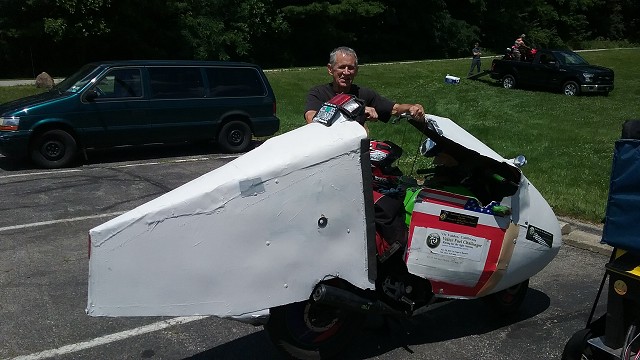
Vic with his bike that he has ridden across the country
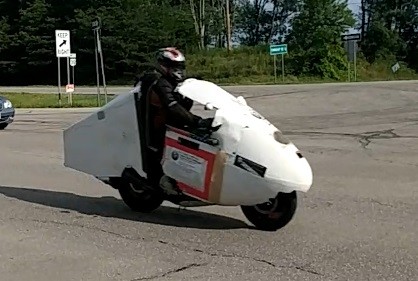
Vic riding in the event, he was our tail rider ("grim reaper") for the 2nd year in a row.
Fuel Efficiency This Ride: 233 mpg
Average Fuel Efficiency During Normal Use:
From: California
Rode In From: Trailered
Used for Commuting/Touring: Touring
Vehicle Year/Make/Model: 1999 Kawasaki 250 Ninja
Rider Comments/Modifications:
Streamlined with Vetter Nose and custom tail
Electric Winner 101.9 Wh/Mile
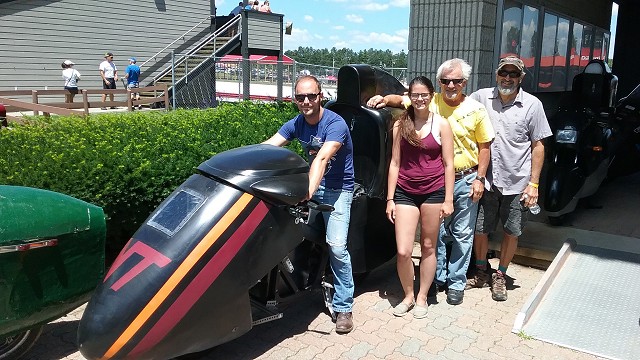
Left to Right: Jake Dennis, Sarah Cartee, Terry Wildman, and Richard Goff
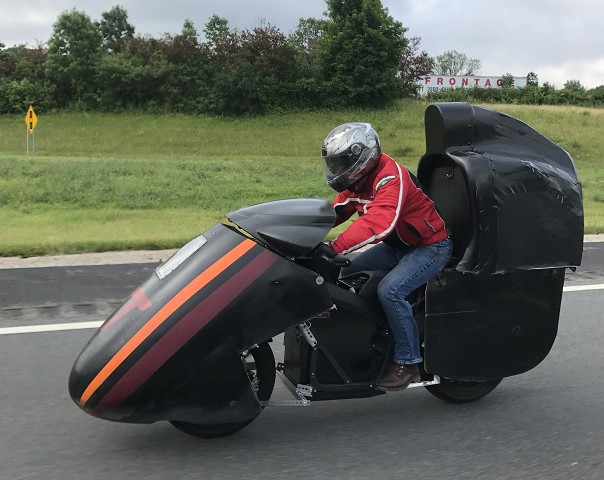
Jake Dennis riding the Virginia Tech bike during the Challenge Ride.
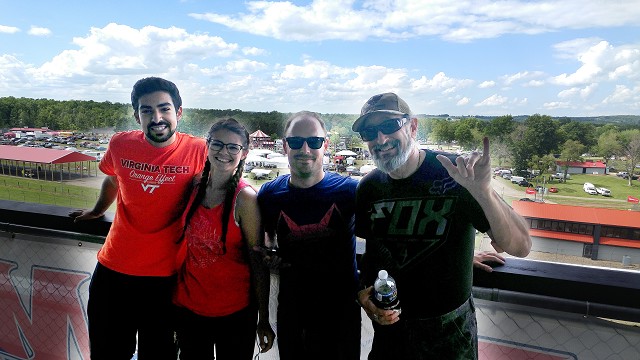
Left to Right: Youssef Bourdi, Sarah Cartee, Jacob Dennis and Richard Goff with a winning team glow.
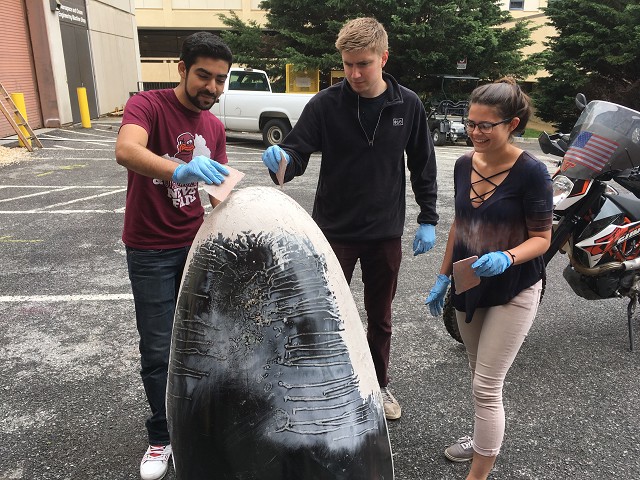
Left to Right: Youssef Bourdi, Pat Rogers ( the team captain of the Virginia Tech Motorcycle Economy Challenge Team, VTMEC), and Sarah Cartee working on the Vetter nose for this year's bike. Pat apprenticed with Craig Vetter in June before Craig's accident.
Fuel Efficiency This Ride: 101.9 Wh/Mile
Average Fuel Efficiency During Normal Use:
From: Virginia
Rode In From: Trailered In
Used for Commuting/Touring: No
Vehicle Year/Make/Model: 2014 Zero S with 11 kW-hour Battery
Rider Comments/Modifications:
102.4 Wh/Mile
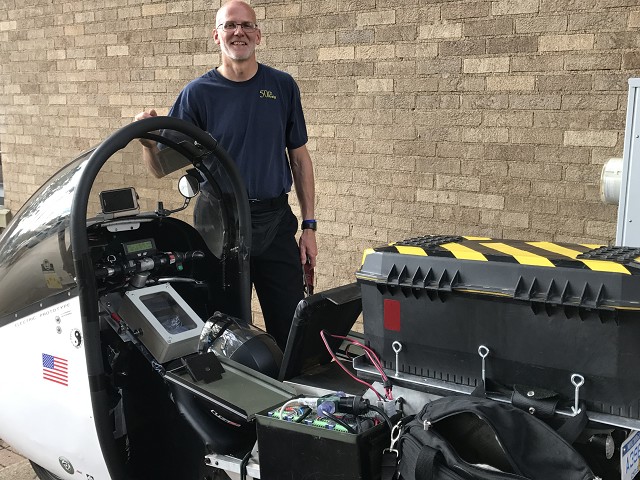
Kraig with his bike during charging
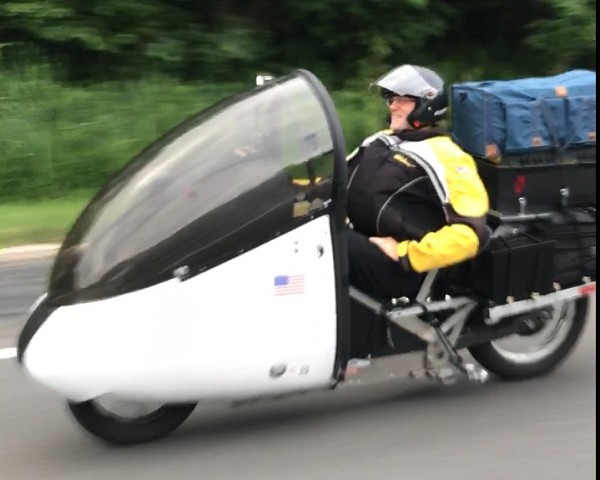
Kraig Riding in this ride
Fuel Efficiency This Ride: 102.4 Wh/Mile
Average Fuel Efficiency During Normal Use: 95.2 Wh/Mile - Life-time Average
From: Grand Haven, Michigan
Rode In From: Trailered in
Used for Commuting/Touring: Commuting
Vehicle Year/Make/Model: 2011 Schultz Engineering, Delta-11 Electric
Rider Comments/Modifications:
This bike was designed and built in 2011 specifically to compete in the Vetter Fuel Economy Challenges.
This is a custom bike incorporating a Ninja 250 front fork and Wheel, a Yamaha SECA 2 rear swingarm and suspension, with a custom non-welded aluminum frame in between that allows for 2 position riding.
It has a 30 kW Peak Enertrac Hub motor in the rear wheel. The controller is de-tuned to 15 kW maximum (20 Hp) to reduce rider induced traffic hazards (i.e. so I don't ride like an idiot).
Since 2015, it has used Chevy Volt batteries. One, 100 pound, 4.5 kWh chuck of Chevy Volt Batteries (28 Cells, 100-112 Volts) is located inside the Frame. A second, 100 pound, 4.5 kWh chunk of batteries is optional and is commonly carried in the passenger area inside a Fatmax Toolbox. The optional battery pack has quick disconnects and can be swapped out with other battery packs that are normally used in my electric car.
All batteries are moved from the bike and used in my electric car during the cold months.
Due to not having a BMS, I manually limit the battery voltage so that only 60% of battery capacity is available per charge (i.e. 5kWh for this ride).
Many technical details can be found here: http://www.evalbum.com/3848
Lifetime fuel economy history on ecomodder http://ecomodder.com/forum/em-fuel-log.php?vehicleid=6947
Full build history http://www.schultzengineering.us/delta-11.htm
This Ride:
As ride leader I was conservative in how I challenged the bike during this years ride. I swapped out the rear battery pack at the Wooster Stop to ensure I would not have any range issues during the ride. I removed all my charging equipment (approx. 100 lbs of chargers and extension cords, etc.) at the Loudonville stop to add ground clearance for the center stand during corners in the Mohican National forest. The bike needs suspension improvements so that it will automatically adjust for adding or removing hundreds of pounds of cargo and battery's while still maintaining safe ground clearance.
This year, I added a text messaging device to text charge status every 15 minutes when charging, otherwise it has the same batteries as 2015 and 2016 challenge rides. Aerodynamically, it's the same bike as from 2011, only it now has 19,500 miles on it.
114 Watt Hours Per Mile
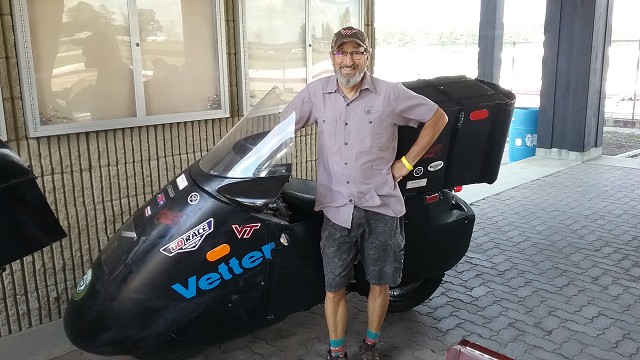
Picture of Bike
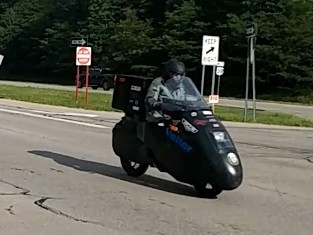
Picture of Bike
Fuel Efficiency This Ride: 114 Wh/Mile
Average Fuel Efficiency During Normal Use:
From: Virginia
Rode In From: Rode Harley in from Virginia, trailered this bike in for the ride
Used for Commuting/Touring: Commuting
Vehicle Year/Make/Model: 2012 Zero DS with 9kWh Battery
Rider Comments/Modifications:
Back to same fairing used during 2014 ride but with added side doors.
128 MPG
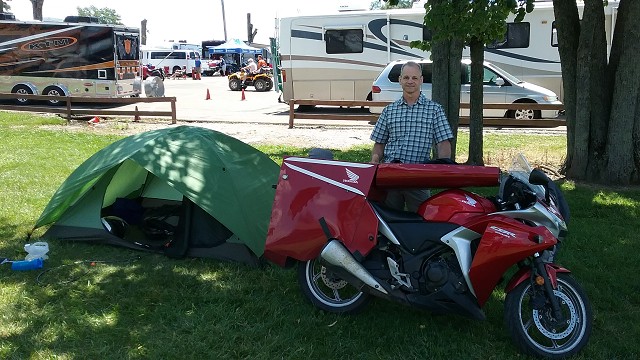
Scott has done many camping/touring trips with his bike since installing the aerodynamic tail with tons of storage.
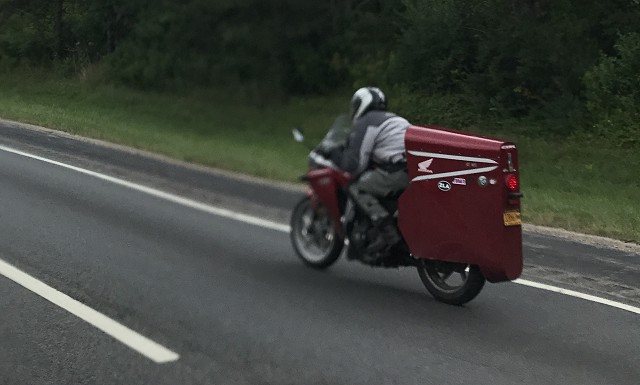
Riding in this years ride
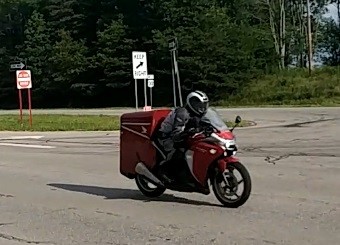
This years ride
Fuel Efficiency This Ride: 128 MPG
Average Fuel Efficiency During Normal Use: 106 mpg normal use on my 80% highway at 68mph commute, average speed 52 mph with traffic stops Ecomodder History
From: New York
Rode In From: New York
Used for Commuting/Touring: Yes
Vehicle Year/Make/Model: 2011 Honda CBR250R
Rider Comments/Modifications:
I didn't make any improvements to my bike this year and did notice a slight reduction in efficiency after replacing the rear brake pads. The piston wouldn't slide back all the way for some reason so I had to sand 30% off of the new pads to get them in so I question if the front and rear planes are still parallel. I still seem to be down a few percent even though that was 2,000 miles ago and I have been purposely overusing the rear brake at every opportunity to bed them into being true. I also ran with my 20,000? mile chain beyond the loose spec (for lack of time) and 7,000 miles on my oil. But I use Motul 300V so it stands up to the long intervals. And this reflects my stance on the event where I encourage people to ride to work on one a 300 class bike or 500 and 700 class Honda world bike and jump in to fuel efficiency more so at the entry level with a board bolted to the back seat and some bungies to get started and not as a high strung competition vehicle with special chains, bearings and internal engine mods.
124 MPG
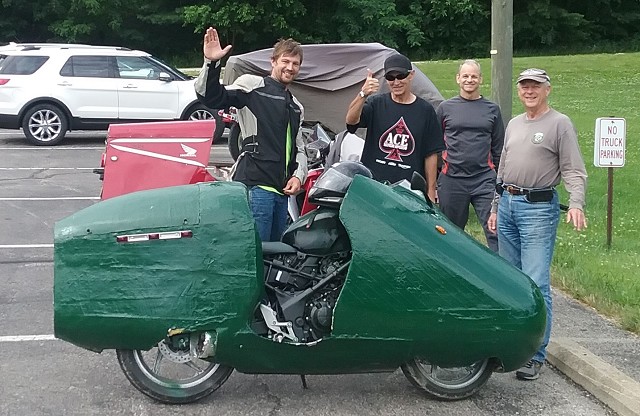
Left to Right: Ben Schloop, Vic Valdes, Scott Endler, Alan Smith
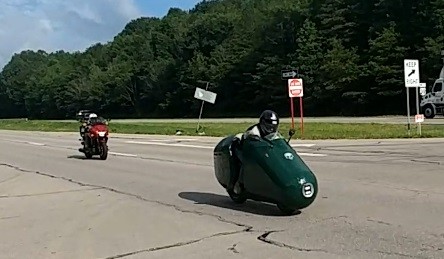
Ben riding bike during this years challenge
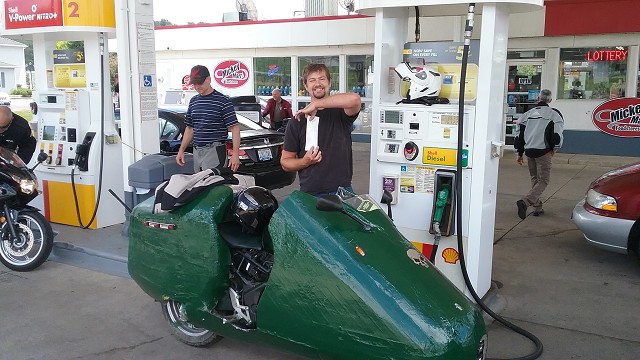
124MPG, Yes!
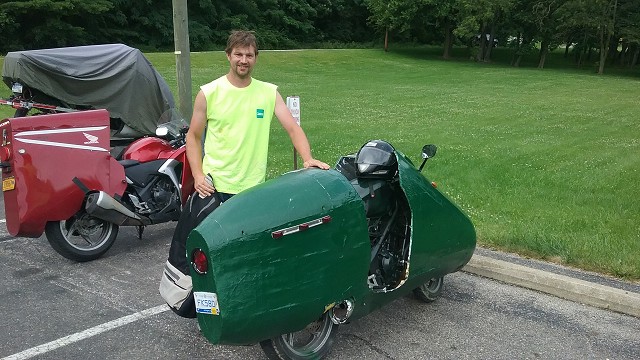
Ben Schloop with the "Green Monster"
Fuel Efficiency This Ride: 124 MPG
Average Fuel Efficiency During Normal Use: 100-110 mpg
From: Grand Rapids, Michigan
Rode In From: Grand Rapids, Michigan at Highway Speeds
Used for Commuting/Touring: Yes
Vehicle Year/Make/Model: 2012 Honda CBR250R
Rider Comments/Modifications:
This was the first year for this bike in competition, so I'll go over the mods from stock. Full streamlined body constructed using fiberglass over foam. Tallest gearing possible using commercially available sprockets. Radiator moved to nose of fairing for more efficient cooling. Led headlight installed in cooling opening.
The ride was lots of fun this year, and I may have been a little too aggressive in my riding style, but this shows that we can engineer a bike capable of anything the average rider might want and still get 100+ mpg. In the next few months I hope to do a bit of refining and get it stable at over 100mph. I also got lots of great ideas from the other riders, especially Alan and Vic. Together I think we can demonstrate a new generation of road worthy machines that are both fun and efficient. Maybe we need to find someone to build an adventure touring bike. That would pretty much complete the lineup.
Congrats on a very successful event to everyone who rode, and thanks a million to Kraig Schultz for organizing the ride.
88 MPG
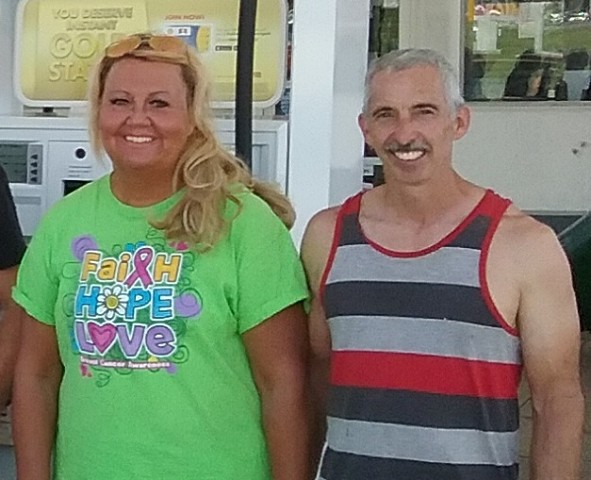
Gail and Gregory Faulkner
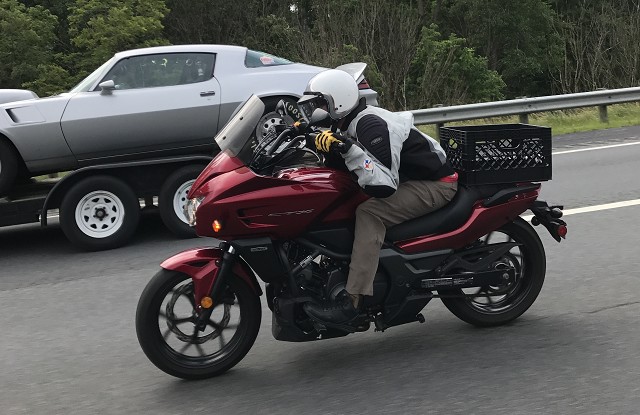
Greg riding bike during 2017 Challenge
Fuel Efficiency This Ride: 88 MPG
Average Fuel Efficiency During Normal Use:
From: Cookeville, TN
Rode In From: Trucked in
Used for Commuting/Touring: Commuting
Vehicle Year/Make/Model: 2014 Honda CTX700
Rider Comments/Modifications:
In the 2014 mid-Ohio Challenge. Variations from pure stock 2014 model CTX700 straight shift and fairing model (red).
(1) after market Madstad 12" adjustable windscreen to help with riding comfort and possibly slightly reduce drag, especially in combination with the next variation; adjusted to full down position.
(2) a Dewalt ToughSystem tool box model DWST08204 that was rectangular and approximately 55 liters for interior dimensions; not large enough to carry 4 bags; and strapped directly to my pillion half of the seat by wrapping around, tying off, and relocking the seat on top of it.
(3) I had removed the stock muffler and replaced it with a straight pipe; painted black about the same length to produce more noise to help me as a new rider know when to shift and to save weight.
(4) Engine and clutch oil Amsoil full synthetic 10W30.
2017 mid-Ohio Challenge.Variations from 2014 challenge. Same windscreen adjusted to the full-down position
(1) replaced Dewalt box with a standard six quart milk crate purchased legally; mounted the same way.
(2) Painted the stock muffler black with Plasti Dip and mounted back on the bike.
(3) Engine oil Pro Honda 10W30 semi synthetic.
Why not four Bags of Groceries or Laundry? "Not even close for me Kraig. Just a rectangular milk crate on my bike. Works great for my commute and everything I use my bike for, but for laundry, I could only wash and dry whites on Saturday; colors have to wait till next laundry trip."
2014 Honda CTX700; manual-shift version with small fairing. Itís got a 670 cc parallel twin that is a very car-like engine with respect to how itís designed and tuned, which makes it very fuel frugal for a mid-sized bike, but not exactly a sport bike; at least from what Iíve read. My history is with scooters. My last scooter was very sporty from my perspective; a Piaggio BV350, and the CTX is at or about the same level of sportiness; only with a little higher top speed which I donít ever try out, and the latter achieves at or about 10 mpg higher for my commute with twice the displacement and twice the cylinders.
At the 2014 event, I had a larger box but not large enough to haul groceries; had my muffler removed and replaced with a straight pipe for a little noise, as I was a new rider and needed the extra noise to help me become a smoother shifting rider. The conical washers that hold up my windscreen broke just before the event started and put the wind right in my face during the ride. By my own recording, I scored 96.9 mpg on that ride that day. I knew during the ride, by the way the fuel gauge was dropping, I was going to get an amazing score on my bike. I mentioned it to other riders. I think it was Alan that said; maybe I was creating sort of a streamline effect via tucking, the broken windshield mount, and the large box. So I donít expect to replicate that score as I did in that accidental perfect set up, but plan to come up and do my best once again to compare against other, mostly-stock bikes and for, most-especially, the comradery.
If I could find an off-the-shelf box big enough to haul groceries that had suitable dimensions so as not to induce drag with my slender body (18-20 inches tall and no more than 15.5 inch wide and about 24Ē long), Iíd get one, strap it on, and be a certified participant; but so far, no luck finding such a store-bought box. Most-likely, Iíll just have the milk crate. Have been achieving upper 70s for my summer time commutes. In 2014, I had been achieving mid 70s with a different set of tires.
In that in 2014 I came in with at least some optimistic trip meter error and the distance ultimately used in the results was even higher than what my bike showed that year. I've been using 2.2% on my fillups both then and now, and based on what I heard and learned from Scott and Ben discussing their estimated trip meter readings and calculated errors, I suspect mine is higher this year with different tires on my bike. This explains why I've been thinking the newer tires have increased my mpg; when in fact, it's likely about the same mpg as before; just more error. Based on the distance being published; that puts me at 3.85% error; and if I go with that 93.7 reading, I'm at 3.63% error. I think I'll just go with 3 3/4 % error and be done with it for now.
On the subject of distance, anything that's decided is fine by me, but I'd like to give just a little insight and observation of my own data and my own unknowns just in case anyone finds it useful or helpful; especially if your going to use an established distance for everyone like has been done in the past. Since acquiring new tires that are a different brand on my bike, I've been averaging a higher mpg number on my summer-time commutes; about 1.5-2 more mpg than before. I really didn't and still don't have a good estimate of whether all of that is a real FE increase or whether part of it is a higher trip meter error. I had made only one quick GPS check for each set of tires on sort of short trips, because I don't have plug in capability to my GPS, and in my rural area, the GPS battery power drains quickly. Both times, once with each set of tires, tracking only about 30 miles, I got at or about 2.2% optimistic on my trip meter, so I always multiply my miles ridden between fill ups by .978, and that's what I gave you after the ride and what I gave Craig in 2014. However, at our first stop Saturday, I over heard Scott and Ben talking about their trip meters; both of them showed less than mine but I didn't take note of the exact difference. I was over 39 and Scott was 38 point something and Ben was far less than that; I think 36 point something. I believe Scott said that his was 2.5% optimistic or so and that Ben's must be recording low. So if that is true, I'm thinking mine is probably a bit more optimistic than the 2.2%; maybe 3 or 3 Ĺ%, but can't give a really good estimate. Scott has the best-guess actual distance information I think.
At the 2014 event, the result I recorded using my own data, using that same 2.2% error, but with the old tires, came out 96.9 mpg; but the official result came in at 101.81 for me and my bike. I can't remember the exact miles I recorded on that day, but I can probably look it up in Fuelly if anyone is that interested! For historical comparison purposes, I personally don't have an issue with one of the higher trip meter numbers being used for official distance, or the average or mode or whatever distance the boss wants to use as it seems like that maybe what's been done in the past. We're not going to be able to be super accurate on distance anyway. I just thought it was worth throwing out there and what I observed.
85 MPG
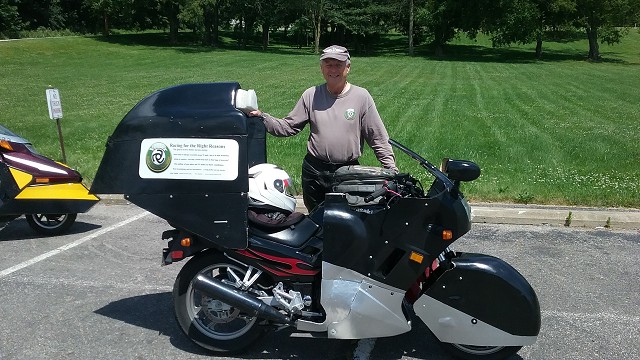
Alan Smith with his bike
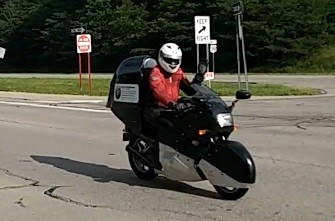
Alan Riding during this years ride
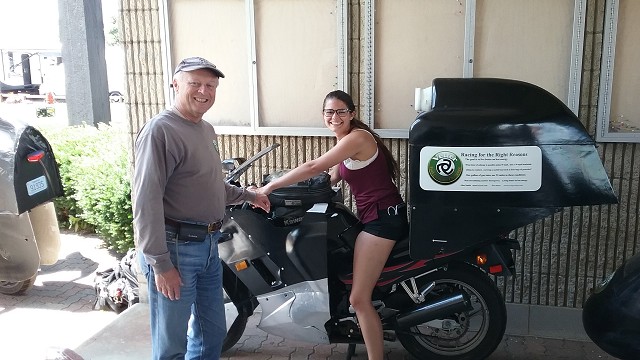
Sarah tries out Alan's Bike
Fuel Efficiency This Ride: 85 MPG
Average Fuel Efficiency During Normal Use:
From: California
Rode In From: California
Used for Commuting/Touring: Yes
Vehicle Year/Make/Model: 2005 Kawasaki 250 Ninja
Rider Comments/Modifications:
This year was a completely different Ninja 250 motorcycle that was not really streamlined. Also this year's motorcycle was not fully developed and did not have the correct sprockets and windshield.
Since we were giving a talk at Vintage Days I thought I should bring a motorcycle that others might want to build.
With a little more refinements I'm sure this motorcycle can get much better fuel economy.
For future trips across the country I will go back to a fully streamlined motorcycle.
79 MPG

Left to Right: Woody Wagaman, Alan Smith, Paul Wright, Finnie Wagaman, Scott Endler, Ben Schloop, Gail Faulkner, Greg Faulkner
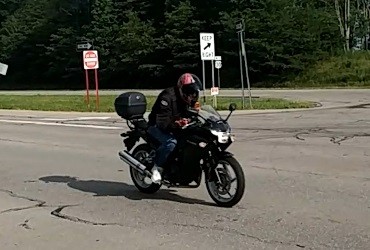
Paul During This Ride
Fuel Efficiency This Ride: 79MPG
Average Fuel Efficiency During Normal Use:
From:
Rode In From:
Used for Commuting/Touring: Commuting
Vehicle Year/Make/Model: 2011 Honda CBR 250R
Rider Comments/Modifications:
76 MPG
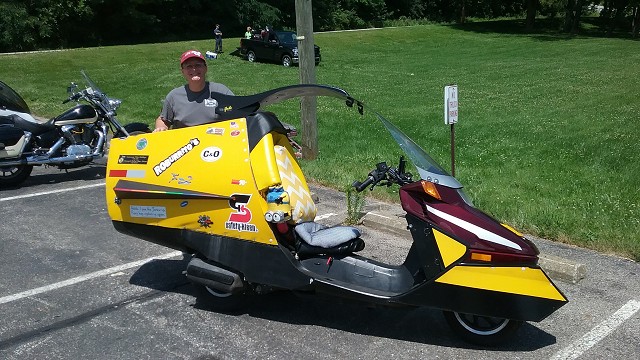
Finnie with Bike
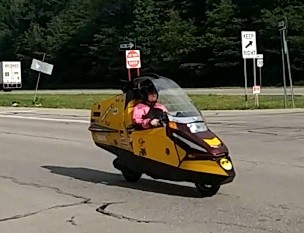
Finnie during the ride
Fuel Efficiency This Ride: 76 MPG
Average Fuel Efficiency During Normal Use:
From: Pennsylvania
Rode In From: Pennsylvania
Used for Commuting/Touring: Yes
Vehicle Year/Make/Model: 2006 CF Moto (Helix Clone)
Rider Comments/Modifications:
47 MPG
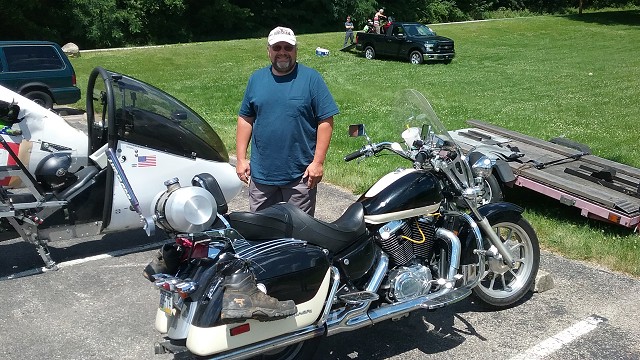
Woody with Bike
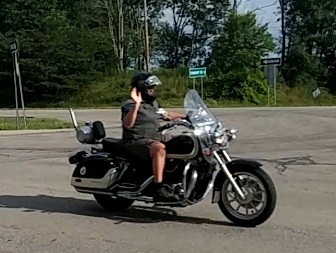
Woody during the ride
Fuel Efficiency This Ride: 47 MPG
Average Fuel Efficiency During Normal Use:
From: Pennsylvania
Rode In From: Pennsylvania
Used for Commuting/Touring: Yes
Vehicle Year/Make/Model: 1998 Honda Shadow Ace 1200
Rider Comments/Modifications:
24 MPG
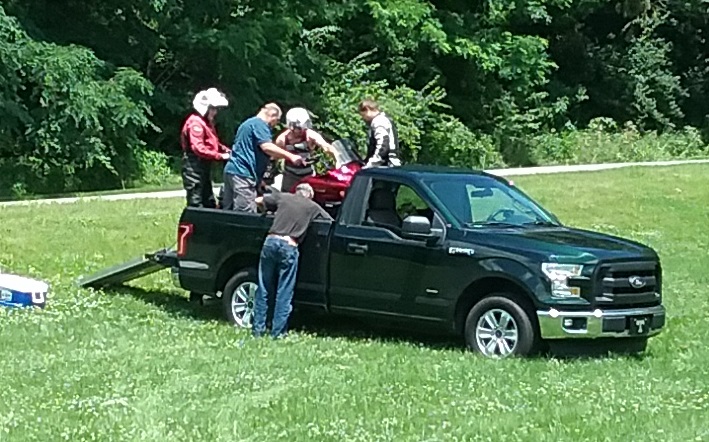
Loading Gregs bike after the ride for the trip home.
Fuel Efficiency This Ride: 24 MPG
Average Fuel Efficiency During Normal Use:
From: Cookeville, TN
Rode In From: Tennessee
Used for Commuting/Touring: Yes
Vehicle Year/Make/Model: 2015 Ford F150 2.7 Ecoboost, std cab, 3.31 RA, 2WD
Rider Comments/Modifications:
2015 F150 with the 2.7 liter Ecoboost this year. Hoping to reach a goal of near 26 mpg in a gas-powered, turbo-charged, DI-powered, full-size truck as a secondary goal this year for the round trip,
Chaser truck miles correction: should have been at least 96.93 or 1.5% more than reported to you originally. Iíve done several GPS odometer checks with this truck and on every occasion where there were no signal drops, the trip meter on the truck has lost between 1.16-1.8 percent to a GPS. And so for fuel economy recording I normally multiply my miles driven by 1.015 to be conservative in my own mpg recording but forgot to make that correction before handing you the receipt. Itís possible that the truck had ľ-1/2 more actual miles than some of the bikes due to parking issues and where the truck ended up after the ride.
The ride was open to all, but to "win" a challenge you will need to ride within the following rules:
http://craigvetter.com/pages/2012-Fuel-contests/2012-challenge-rules.html
Contact Kraig Schultz (Volunteer Coordinator for 2017 Mid-Ohio Craig Vetter Fuel Economy Challenge)
E-mail: kraig@schultzengineering.us
Phone: 616-540-7027
History: From 1980-1985, Craig Vetter (the inventor of the ďWind JammerĒ motorcycle fairing), hosted an annual fuel economy competition in California. Participants in the competition were able to get up to 470 miles per gallon at the then national speed limit of 55mph. Craig Vetter Website
Beginning in 2011, spurred by rising gasoline prices, Craig Vetter once again began coordinating rides. A small group of people who are working on improving fuel economy for motorcycles gather from all over the country to participate in the Vetter Fuel Economy Rides. We have met at Mid-Ohio Vintage Motorcycle Days each year since 2011 to showcase what we have learned and to participate in a Fuel Economy Demonstration Ride. The rides are free and open to the public. The rides are conducted to raise public awareness, foster innovation and to share ideas with a goal of publicizing motorcycle designs that are highly efficient and practical for everyday riding.
Here's a picture I took of Craig Vetter sitting in front of his original streamliner from the 1980's while he told me the story about how it started out the "only proper color for a streamliner (silver)" and got painted blue after being broken in two in a crash.
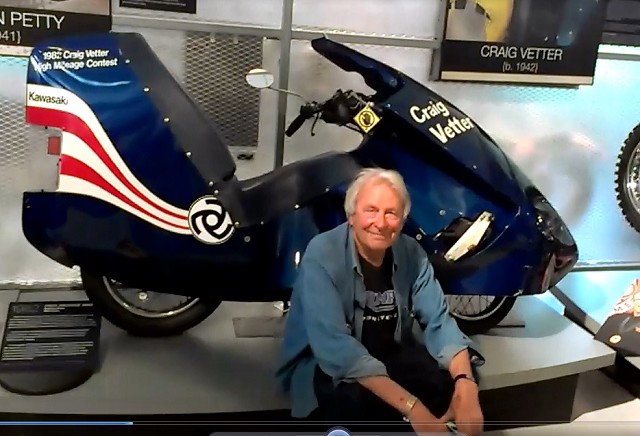
Craig is recovering from a hitting a deer while riding his streamliner on August 14, 2015. To help him stay focused on his recovery, we have volunteered to help keep the Vetter Challenge Rides going while he recovers.
Note: While he was not up to making the trip from California in person this year, Craig Vetter attended a talk via Skype at 11:30am Sunday, July 9, at the Goodyear Tower at the Mid-Ohio Raceway.
